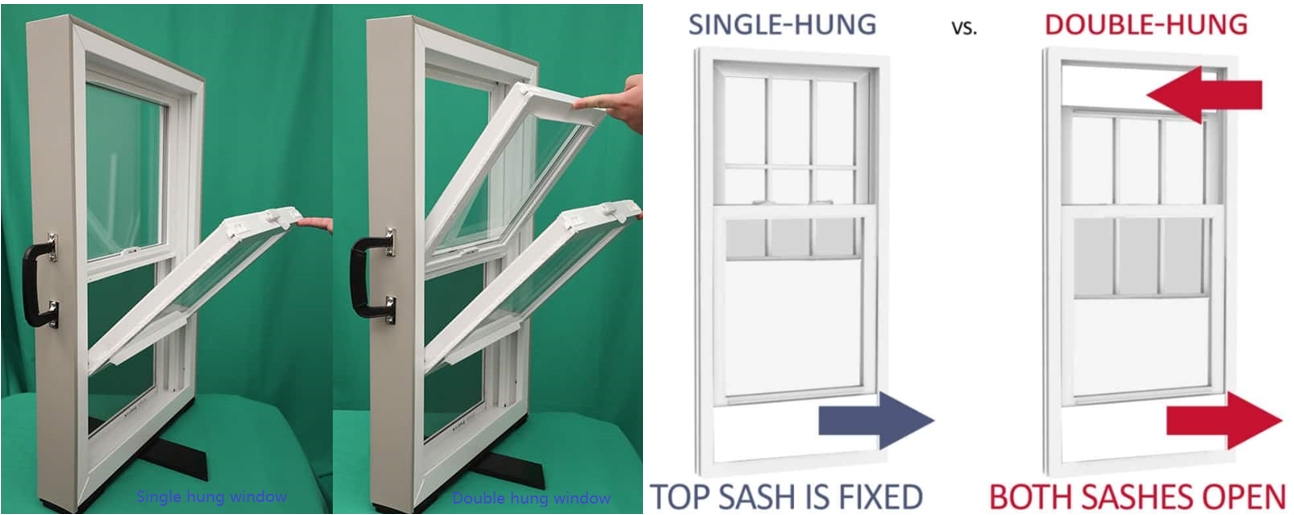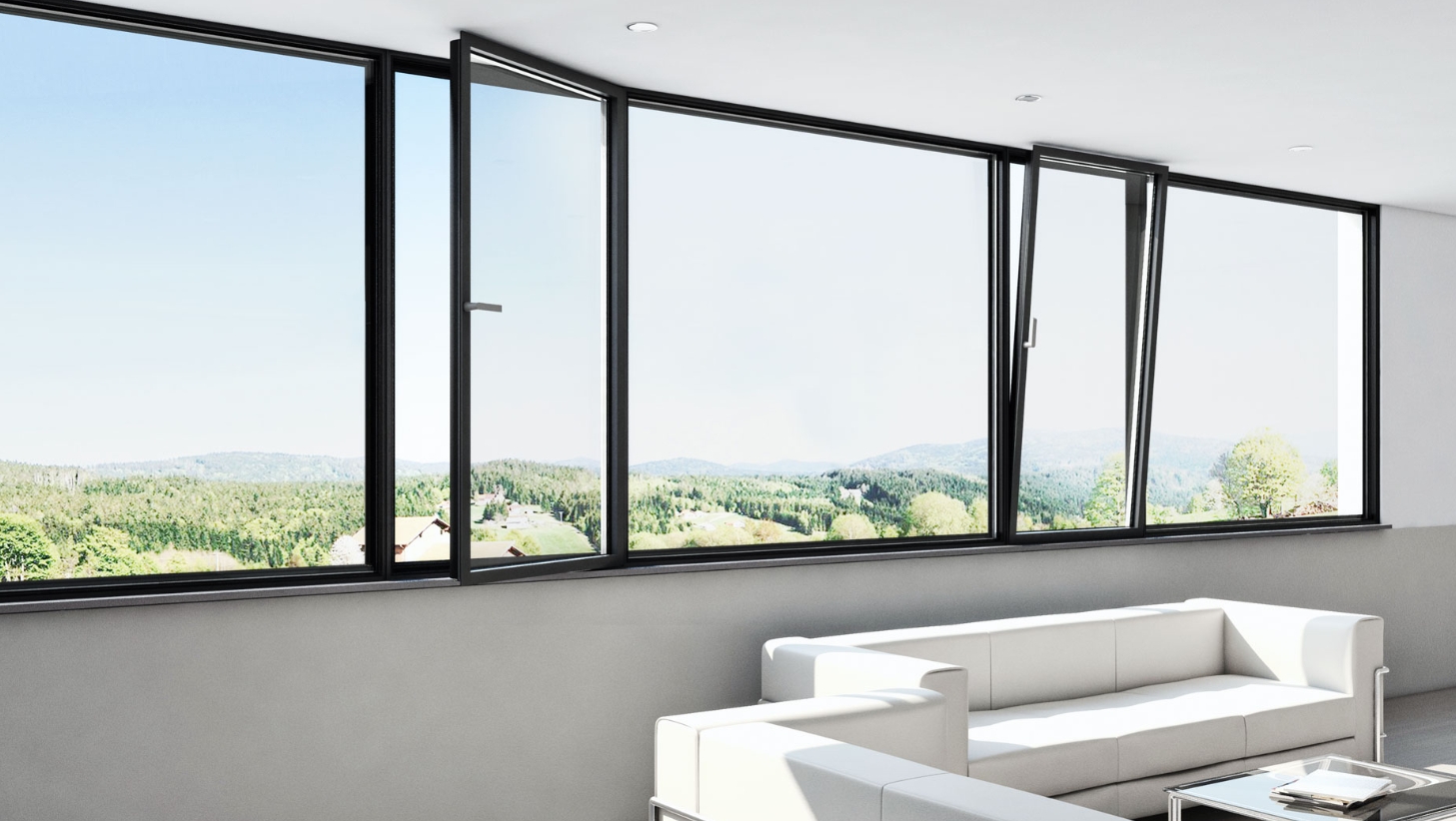We understand that the numerous window styles and confusing terminology can be overwhelming. That’s why we have created this user-friendly window tutorial to clarify the differences, names, and advantages of each style. By familiarizing yourself with this guide, you’ll be better equipped to choose the ideal windows for your needs in the future. So, let’s dive into this guide:
1, Single Hung Windows
A single hung window, also called sash windows or hung sash windows are made of one or more movable panels, or “sashes”, is a window design that has a fixed upper frame and a lower frame that slides up and down. The upper frame remains fixed, while the lower frame can be opened for ventilation. This is a classic and affordable window design commonly found in residential buildings and suitable for various rooms such as bedrooms, living rooms, offices, etc. It can provide good ventilation, while also having better energy-saving performance and visibility.
2,Double Hung Windows
Double-hung windows are popular due to their versatility. They consist of two frames that slide up and down for ventilation. They can be opened flexibly by sliding the bottom frame up or the top frame down. For example, if you want fresh air but not a draft, you can pull down the upper frame. You can also have cool air come in through the bottom while warm air exits the top by pulling down the upper frame and raising the lower frame simultaneously. Many double-hung windows tilt for easy cleaning, making them convenient for higher floors. These features make them more expensive than single-hung windows of the same size.
3, Sliding Windows
Sliding windows provide a different way to open and close compared to traditional hung sash windows. Instead of sliding the sashes vertically, sliding windows slide horizontally from left to right or vice versa. Essentially, they are like double-hung windows positioned on their sides.
These windows are particularly suitable for wider windows rather than taller ones. They also offer a wider and more unobstructed view compared to other window types. So, if you’re looking for a window that allows for a broader view and operates by sliding side to side, slider windows are an excellent choice.
4,Casement Windows
Casement windows, commonly referred to as crank windows due to the use of a crank to open them, are often selected for tall, narrow openings. Unlike traditional windows, casement windows are hinged on one side and swing outward, resembling the movement of a door. This design proves advantageous in situations where accessibility to the window is limited, such as when it is positioned higher on the wall or requires reaching across a counter to open.The presence of a crank at the bottom of the window ensures easy opening and closing, making it more convenient than lifting a single or double hung window. Casement windows typically consist of a single pane of glass without grilles, thereby offering an unobstructed view that places emphasis on the surrounding scenery. Moreover, an open casement window acts akin to a sail, capturing breezes and directing them into the home, effectively enhancing ventilation.
5,Bay Windows
Bay windows are expansive windows consisting of multiple sections that extend outward from the exterior wall of a house. They come in various styles, such as three-window or four-window configurations. The central window of a bay window offers unobstructed views, while the side windows can be operated as casement or double-hung to enable ventilation. Incorporating a bay window instantly adds a touch of sophistication and charm to any room by allowing ample natural light to flood in, creating a spacious and airy ambiance. Not only does it visually enhance the perceived size of the room, but it can also expand the physical footprint of the space as it extends beyond the exterior wall, reaching down to the floor.
6, Bow Windows
Bow windows offer similar advantages as bay windows, creating a bright and spacious atmosphere while providing picturesque views of the outside. They are especially suitable when space is limited and a bay window is not feasible. While both styles project outward, bow windows do not extend as far as bay windows. This makes them a great option when dealing with a window that faces a porch or walkway, as a bay window might encroach too far into the space, whereas a bow window would fit comfortably.
7,Awning Windows
An awning window is named for its unique design, with a single pane that is hinged at the top of the frame. This configuration creates an awning-like effect when the window is open. Similar to a casement window turned sideways, awning windows offer versatility and functionality. One notable advantage of awning windows is their smaller size, which makes them suitable for installation at higher positions on walls. This placement not only adds architectural interest but also allows for ventilation and natural light without compromising privacy or security. One of the standout features of awning windows is their ability to provide ventilation even when it’s raining. The top-hinged pane effectively keeps water out while still letting fresh air flow in. Awning windows come in various styles, ranging from simple and unadorned designs to those with decorative grilles. Overall, awning windows are a practical choice for those looking to enhance both the aesthetics and functionality of their living space.
8, Tilt & Turn Windows
Tilt & turn windows provide users with two versatile options. With a 90-degree turn of the handle, the window sash swings open into the room, similar to an inward-opening casement window. Alternatively, a 180-degree turn of the handle allows the sash to tilt inward from the top, providing both ventilation and security at the same time. These windows are often chosen as egress windows due to their size, which allows for easy entrance and exit. Additionally, larger tilt & turn windows can even provide access to outdoor spaces such as a roof or balcony. In summary, tilt & turn windows offer convenience, flexibility, and safety for any living space.
We hope this helps you understand the difference between all of the different types of windows and helps you decide which windows to use where. If you want more info, feel free to contact us.
Tel/WhatsApp: +86 17688923299 E-mail: aisling.huang@aluminum-artist.com
Post time: Nov-27-2023









